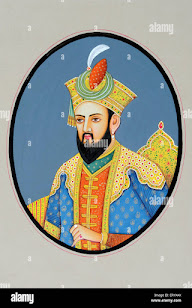Mughal king Humayun
Welcome to the story of Mughal king Humayun, who is remembered as a significant ruler in the history of India. Humayun was the second Mughal emperor, succeeding his father Babur, and his reign laid the foundation for the Mughal empire's growth and prosperity.
BIOGRAPHY:
Humayun was born in Kabul, Afghanistan in 1508, to Babur and his wife, Maham Begum. He was the eldest son of Babur, who founded the Mughal empire in India in 1526. Humayun received a good education in Arabic, Persian, and Turkish languages and military strategies. He also had a keen interest in astronomy and philosophy.
FAMILY:
Humayun's family was an important part of his life. He had several wives and concubines, but his marriage to Hamida Banu Begum was the most significant one. She was the mother of his son and successor, Akbar. Humayun had two other sons, Kamran and Askari, who played a significant role in the Mughal empire's history. Humayun's father Babur was also an essential figure in his life, who trained him in military tactics and administration.
CONQUEST:
Humayun's reign was not without challenges. He faced several battles and uprisings, including the rebellion of his own brothers. In 1540, Sher Shah Suri, one of Humayun's rivals, defeated him in the Battle of Kannauj and took over the Mughal empire. Humayun was forced to flee to Persia, where he sought help from the Safavid dynasty. With the help of the Persian ruler, Shah Tahmasp, Humayun regained control of the Mughal empire in 1555.
ROLE MODEL:
Humayun is remembered as a compassionate and just ruler who cared for his people. He was known for his humility and kindness, which earned him the respect of his subjects. Humayun's love for knowledge and culture also played an essential role in the Mughal empire's development. He was a patron of the arts, and his court was a center of poetry, music, and literature.
Architectural:-
India has been home to a rich legacy of marvels that have stood the test of time. One such exquisite example is the tomb of Mughal king Humayun.
Humayun, the second Mughal emperor, ruled India in the 16th century. He was known for his love for art, culture, and architecture.
Narrator (voice-over): In 1533, Humayun ascended to the throne of Delhi and became the ruler of an empire that spanned across much of present-day India, Pakistan, and Bangladesh.
It was during his reign that the construction of his tomb began, which is now famously known as the Humayun's Tomb.
The tomb was built in the year 1569, and it took almost nine years to complete. It was constructed by Persian architect Mirak Mirza Ghiyas, who was appointed by Humayun's wife, Empress Bega Begum.
The tomb is a beautiful amalgamation of Persian and Indian architecture. The structure is built using red sandstone, and the domed roof is made of white marble. The intricate carvings and inlay work on the walls and ceilings are a testament to the artistic and architectural excellence of that era.
The tomb houses the remains of Humayun, as well as several other members of the Mughal dynasty. The tomb also has several other buildings and gardens around it, including a mosque, a pavilion, and a bathhouse.
Today, the Humayun's Tomb is a UNESCO World Heritage Site and attracts visitors from all over the world. It is not just a beautiful structure, but also an important part of India's history and culture.
The Humayun's Tomb is a testament to the architectural excellence of the Mughal era, and it will continue to inspire awe and admiration for generations to come.
Humayun was the second Mughal emperor who ruled India from 1530 to 1540 and then from 1555 until his death in 1556.
CONCLUSION:
Humayun's reign was short-lived, but he left a lasting legacy in Indian history. His conquests and achievements laid the foundation for the Mughal empire's growth and prosperity under his son Akbar. Humayun's life is a testament to the power of perseverance, and he is an inspiration to many



Comments
Post a Comment